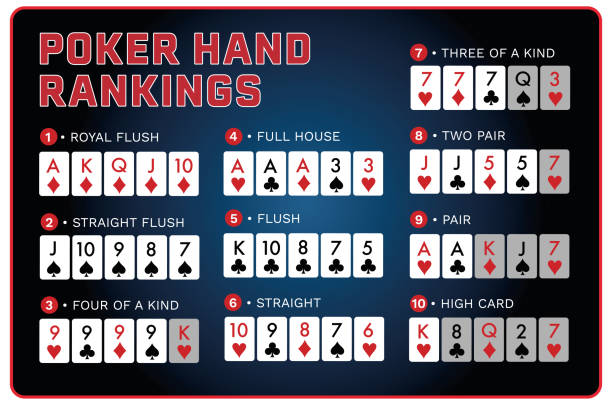Poker is a casino game that has been played for centuries. However, it has only gained popularity in the past few decades. It is a game that requires skill, strategy, and luck. It attracts players of all levels of expertise, from beginners to professional players. In this article, we will provide a comprehensive guide to playing poker, covering the rules, strategies, and etiquette of the game.
Definition of Poker
Poker is a card game that involves betting and individual play. The objective is to win the pot by having the best hand or by convincing all the other players to fold. Furthermore, the game has a standard deck of 52 cards, and the ranking of the hands determines the winner.
History of Poker
The origins of poker are unclear. However, it is believed to have been played as early as the 16th century in Europe. Over time, different variations of the game emerged in different regions. It eventually became a staple of American culture during the 19th century. Since then, poker has spread around the world and has become one of the most popular card games.

Popularity of Poker
Poker has gained immense popularity over the years, with millions of players worldwide. The World Series of Poker, an annual tournament held in Las Vegas, is considered the most prestigious event in the poker world. Prize pools are reaching tens of millions of dollars. The rise of online poker has also contributed to the game’s popularity, making it accessible to players from all over the world.
Poker Rules and Gameplay
Basic Rules of Poker
Poker is a game that can be played with anywhere from two to ten players, using a standard deck of 52 cards. Each player is dealt a hand of cards, and the game proceeds with a series of betting rounds. The objective of the game is to win the pot by having the best hand or by convincing all the other players to fold.
The game begins with each player receiving two cards face down, which are called the hole cards. The first betting round, called the pre-flop, begins with the player to the left of the big blind. The big blind is a forced bet that is made by the player to the left of the dealer. It is typically twice the size of the small blind. The small blind is a forced bet that is made by the player to the left of the dealer. It is typically half the size of the big blind.
Hand Rankings
Understanding hand rankings is essential to playing poker. The highest-ranking hand is the royal flush, which consists of a straight flush from ace to ten. The straight flush is the second-highest hand, followed by four of a kind, full house, flush, straight, three of a kind, two pairs, one pair, and high card. However, if two players have the same hand, the winner is determined by the highest card.
Different Types of Poker Games
There are many different variations of poker, each with its own set of rules and strategies. Some of the most popular types of poker games include Texas Hold’em, Omaha, Seven Card Stud, and Razz.
Texas Hold’em
Texas Hold’em is the most popular form of poker. It is played with two cards dealt to each player. They are followed by five community cards that are shared among all the players. The game is won by the player with the best five-card hand using any combination of their two cards and the five community cards.
Omaha
Omaha is a variation of Texas Hold’em in which each player is dealt four cards instead of two. Players must use two of their four cards and three of the five community cards to form their hand.
Seven Card Stud
Seven Card Stud is a classic poker game that was popular before Texas Hold’em became the dominant game. Each player is dealt seven cards, and the game proceeds with a series of betting rounds, with the objective of making the best five-card hand.
Razz
Razz is a variation of Seven Card Stud in which the objective is to make the lowest possible hand, rather than the highest.
How to Play Texas Hold’em?
Texas Hold’em is the most popular form of poker. It is played with two cards dealt to each player. They are followed by five community cards that are shared among all the players. The game is won by the player with the best five-card hand using any combination of their two cards and the five community cards.
The game begins with each player receiving two cards face down, which are called the hole cards. The first betting round, called the pre-flop, begins with the player to the left of the big blind. The big blind is a forced bet that is made by the player to the left of the dealer. It is typically twice the size of the small blind. The small blind is a forced bet that is made by the player to the left of the dealer. It is typically half the size of the big blind.

After the pre-flop betting round, three community cards are dealt face up in the middle of the table, which are called the flop. The second betting round begins with the player to the left of the dealer. The minimum bet is usually twice the size of the big blind.
What comes next?
After the second betting round, a fourth community card is dealt face up in the middle of the table, which is called the turn. The third betting round begins with the player to the left of the dealer. The minimum bet is usually twice the size of the big blind.
After the third betting round, a fifth and final community card is dealt face up in the middle of the table, which is called the river. The fourth and final betting round begins with the player to the left of the dealer. The minimum bet is usually twice the size of the big blind.
If there are two or more players remaining after the final betting round, a showdown occurs. Furthermore, the player with the best five-card hand using any combination of their two cards and the five community cards wins the pot.
Poker Strategy
Importance of Position
The position of a player at the table is crucial in poker, as it can greatly influence the player’s decision-making and potential to win. Players in later positions have more information about their opponents’ actions and can make more informed decisions.
The three main positions at the poker table are the early position, the middle position, and the late position. The early position is the first few players to act. They have the least amount of information about their opponents’ actions. The middle position players have more information, as they can see the actions of the early position players. However, they still have less information than the late position players. The late position players have the most information, as they can see the actions of all the other players before they make their decision.
Reading Your Opponents
One of the keys to success in poker is the ability to read your opponents. This involves paying attention to their behavior, body language, and betting patterns to gain insight into their hands and bluffing tendencies.
Some common tells that can indicate whether a player has a strong or weak hand include shaking hands, rapid breathing, and hesitating before making a bet. However, it is important to note that not all tells are reliable. However, some players may deliberately give false tells to deceive their opponents.
Bankroll Management
Bankroll management is crucial in poker, as it determines how much money a player can afford to lose without risking their entire bankroll. A general rule of thumb is to keep at least 20 buy-ins for the game you are playing to minimize the risk of going broke. For example, if you are playing in a $1/$2 No-Limit Hold’em game, you should have a bankroll of at least $4,000.

Bluffing and Semi-Bluffing
Bluffing is a common strategy in poker, where a player pretends to have a better hand than they actually do to force their opponents to fold. It can be a powerful tool, but it should be used sparingly and strategically. It is important to pay attention to the board and the other players’ behavior before attempting to bluff, as it can be risky if done at the wrong time.
Semi-bluffing is a similar strategy, where a player bluffs with a hand that has the potential to improve on future community cards. This can be a more effective strategy than pure bluffing, as it gives the player a chance to win the pot even if they do not have the best hand at the time.
Poker Tournaments
Types of Poker Tournaments
Poker tournaments come in various formats, each with their own set of rules and strategies. Some of the most common types of poker tournaments include:
- Freezeout Tournaments: In freezeout tournaments, players face elimination once they lose all their chips. The last player standing wins the tournament.
- Rebuy Tournaments: In rebuy tournaments, players can buy back in if they lose all their chips. This can result in larger prize pools and longer playing times.
- Shootout Tournaments: In shootout tournaments, players must win their table to advance to the next round. The winner of the final table is the tournament winner.
- Satellite Tournaments: In satellite tournaments, players can win a seat at a larger tournament by placing in the top positions.
Strategies for Winning Tournaments
Winning a poker tournament requires a different set of strategies than playing in a cash game. These include being patient, taking advantage of opportunities, and adjusting to changing conditions throughout the tournament.
It is important to start out conservatively and only play strong hands early on in the tournament. As the blinds increase and the number of players decreases, it becomes more important to be aggressive and take advantage of opportunities to accumulate chips. It is also important to pay attention to the other players’ chip stacks and adjust your strategy accordingly.
Famous Poker Tournaments
The World Series of Poker is the most famous poker tournament in the world, attracting thousands of players each year to compete for millions of dollars in prize money. Furthermore, other famous tournaments include the European Poker Tour and the World Poker Tour.
Online Poker
Advantages of Playing Online
Online poker has become increasingly popular in recent years, offering players the convenience of playing from anywhere at any time. Online poker also offers a wider range of game types and stakes compared to live poker. Players can also take advantage of bonuses and promotions offered by online poker sites.
Choosing an Online Poker Site
Choosing the right online poker site is crucial, as it affects the player’s overall experience and safety. Factors to consider include the site’s reputation, game variety, bonus offers, and payment options. It is important to choose a site that is regulated and licensed by a reputable gaming commission to ensure fair play.
Staying Safe Online
Staying safe when playing online poker involves being cautious with personal information and avoiding unregulated sites. Players should also ensure that the site they are playing on uses secure encryption and regularly audits their games for fairness. It is also important to practice responsible gambling habits and never gamble more than you can afford to lose.
Poker Etiquette
Rules of Poker Etiquette
Poker etiquette is important to ensure a fair and respectful playing environment for all players. Some common rules of poker etiquette include:
- Not acting out of turn: Players should wait for their turn to act and avoid making any actions or statements that may influence other players’ decisions.
- Keeping track of chips: Players should keep their chips organized and visible to other players, and avoid splashing the pot (throwing chips into the pot).
- Being respectful to other players: Players should avoid making personal attacks or insults towards other players, and refrain from distracting behavior such as excessive talking or phone use.
- Following the rules: Players should be familiar with the rules of the game and follow them to ensure a fair and enjoyable playing experience for all.
Tipping Dealers and Staff
Tipping dealers and staff is common in live poker games. It is a way to show appreciation for their services. Moreover, the amount of the tip can vary depending on the size of the pot and the quality of service. However, a general rule of thumb is to tip around 1-2% of the pot.
Conclusion
Poker is a game that requires skill, strategy, and luck. It has become one of the most popular card games in the world. Understanding the rules, hand rankings, and different types of poker games is crucial to playing the game successfully. Additionally, developing a strong poker strategy can increase your chances of winning. Whether playing in a live game or online, it is important to practice responsible gambling habits and adhere to poker etiquette to ensure a fair and enjoyable playing environment for all.
